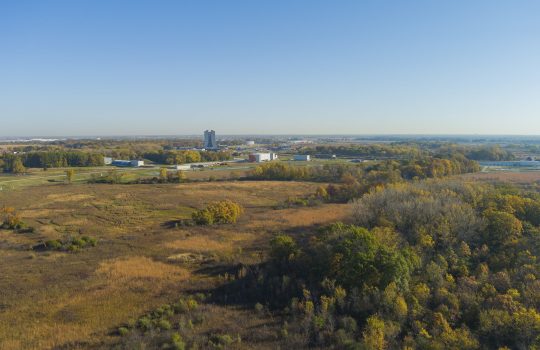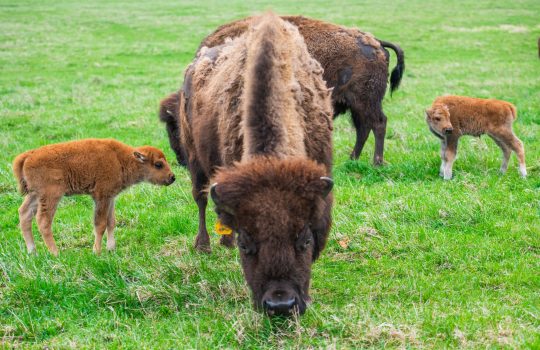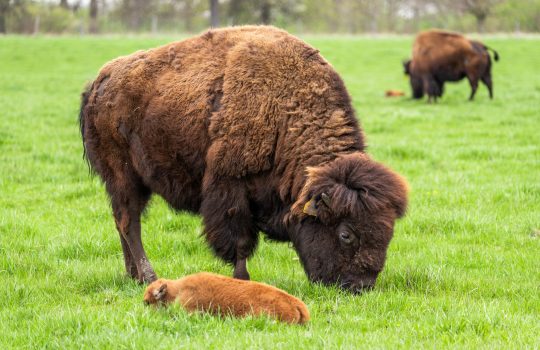
Whether at work or in his personal life, Fermilab ecologist Wally Levernier enjoys the great outdoors. Photo: Wally Levernier
What is your role at the U.S. Department of Energy’s Fermi National Accelerator Laboratory?
I have been the lab ecologist since October 2018. The ecologist at Fermilab has many roles. I am the chair of the Ecological Land Management Committee, which meets monthly and helps direct the ecology at the lab. I coordinate National Environmental Research Park projects at the lab; this is a designation that allows outside environmental researchers to come to Fermilab and study many aspects of the environment. I am also liaison to Fermilab Natural Areas, the organization that helps to monitor and manage the ecology of Fermilab.
On a day-to-day basis, I conduct invasive species control, collect native seed, conduct plant surveys of our natural areas, plan special projects, lead prescribed burns, help coordinate new construction to minimize environmental impacts, lead FNA workdays, work with the education center for educational opportunities. The job is incredibly diverse.
How did you become interested in ecology?
I have been interested in ecology before I knew what ecology was. When I was young, I spent most of my time outdoors chasing frogs, fishing, and gardening with my grandfather. I also went to outdoor camps in grade school over the summer at McHenry County Conservation District.
What do you like best about working at Fermilab?
The natural areas at Fermilab are unique. The history of the prairie restoration is one of the things I like most. Fermilab started prairie restoration in the mid-70s before it was a common practice. I also enjoy working with FNA; they are dedicated to and passionate about restoration and the environment.
What are the projects you’re working on now with Fermilab?
We have planned some special restoration projects with FNA to restore more suitable nesting habitat for rapidly declining grassland and shrubland nesting bird species.
In the Eola Grassland project, we are planning on removing brush in order to create better nesting habitat. These bird species require large areas that have no trees and few shrubs to nest. We are experimenting with different methods — prescribed burning versus frequent mowing — to see if there is a treatment that nesting birds prefer.
In the Sparrow Hedge, which is shrubland by A.E. Sea, we are planning on trying to create a diverse habitat of native shrubs by removing all trees and non-native shrubs. This is very difficult habitat to restore and maintain. This habitat tends to transition between prairie and savanna/woodland so it is difficult to try and make it somewhat static. It is basically a mixture of grasses, sedges and wildflowers with intermixed shrub clumps. These clumps vary in species, size, distance between clumps, etc. to try to accommodate the preferences of many species.
What are FNA workdays?
Fermilab Natural Areas workdays are where members of FNA come on site to assist with natural areas management activities. Each workday is different. During the winter and spring, we tend to conduct invasive bush removal. Summer and fall workdays tend to be a mixture of brush removal and native seed collection; we manage other invasive species as well. It is a great community-building activity.
What’s the most rewarding part of your job?
Knowing that you are working to preserve plant and animal species in the region, many of which are in decline, is rewarding. So is helping people to learn about and become passionate about nature and ecology. We need more people to care about and interact with the environment.
What is the most challenging part of your work?
We are a small group and depend on the support of others to accomplish our goals. We are only able to complete a portion of what needs to be completed.
One way we prioritize is by determining areas of rare plants and animals and work on those areas. We also identify communities that are in better shape and try to preserve those first. Discussion and planning from the ELM committeealso helps to determine priorities.
Does the lab mark any ecological observances?
Yes. Events are held during the week of Earth Day, and all of the topics have relevance to the environment. This year, I led a virtual wildflower walk on Thursday, April 21, where I also discussed the ecology of Fermilab.
Also, in the past, our Roads and Grounds group has held an Arbor Day planting, which occurs during Earth Week. We hope to continue this again next year.
What do you like to do when you are not working?
I enjoy being outdoors. We hike with our dog in local forest preserves. We enjoy traveling and birding. I also enjoy photography.
Fermi National Accelerator Laboratory is supported by the Office of Science of the U.S. Department of Energy. The Office of Science is the single largest supporter of basic research in the physical sciences in the United States and is working to address some of the most pressing challenges of our time. For more information, please visit science.energy.gov.



